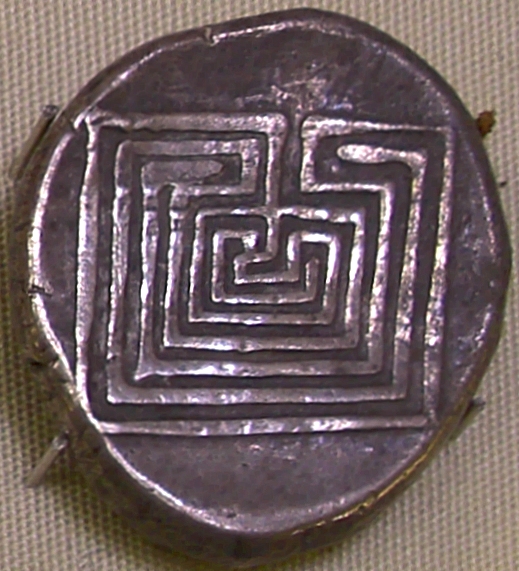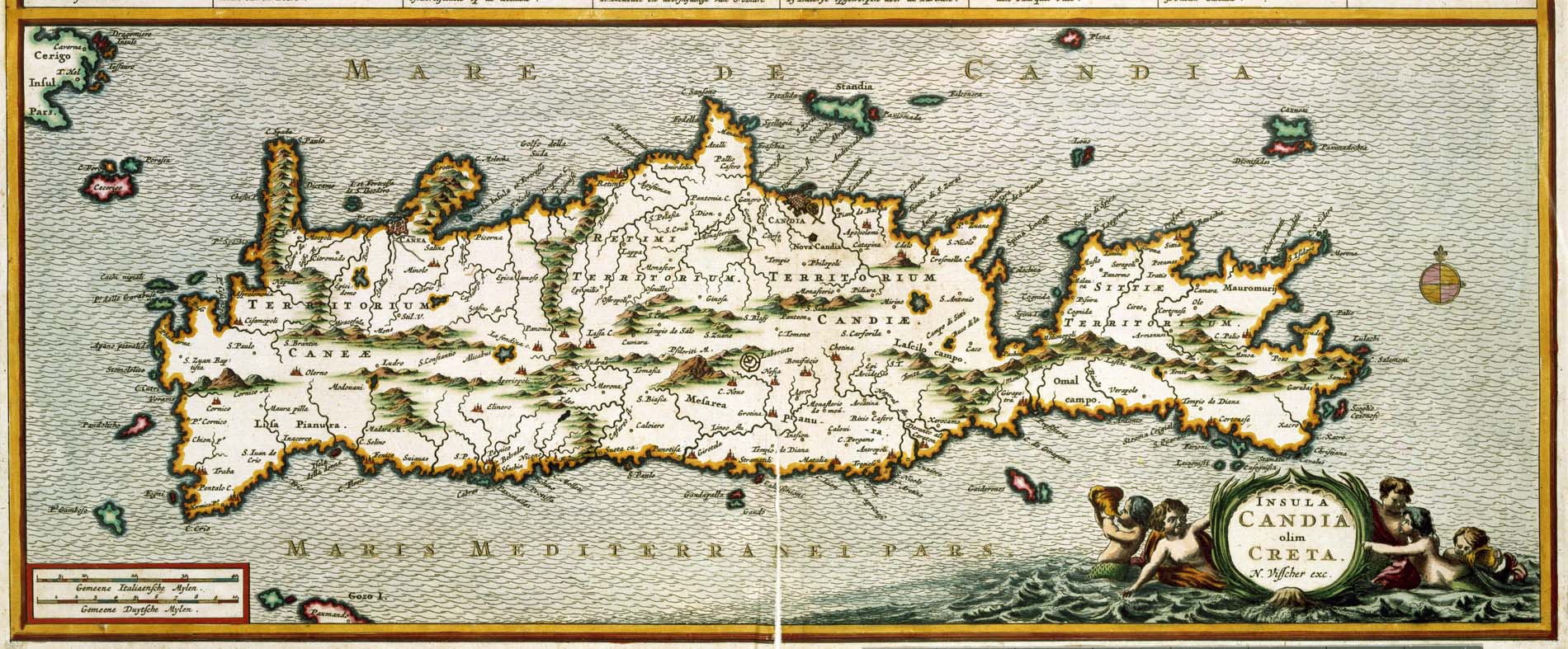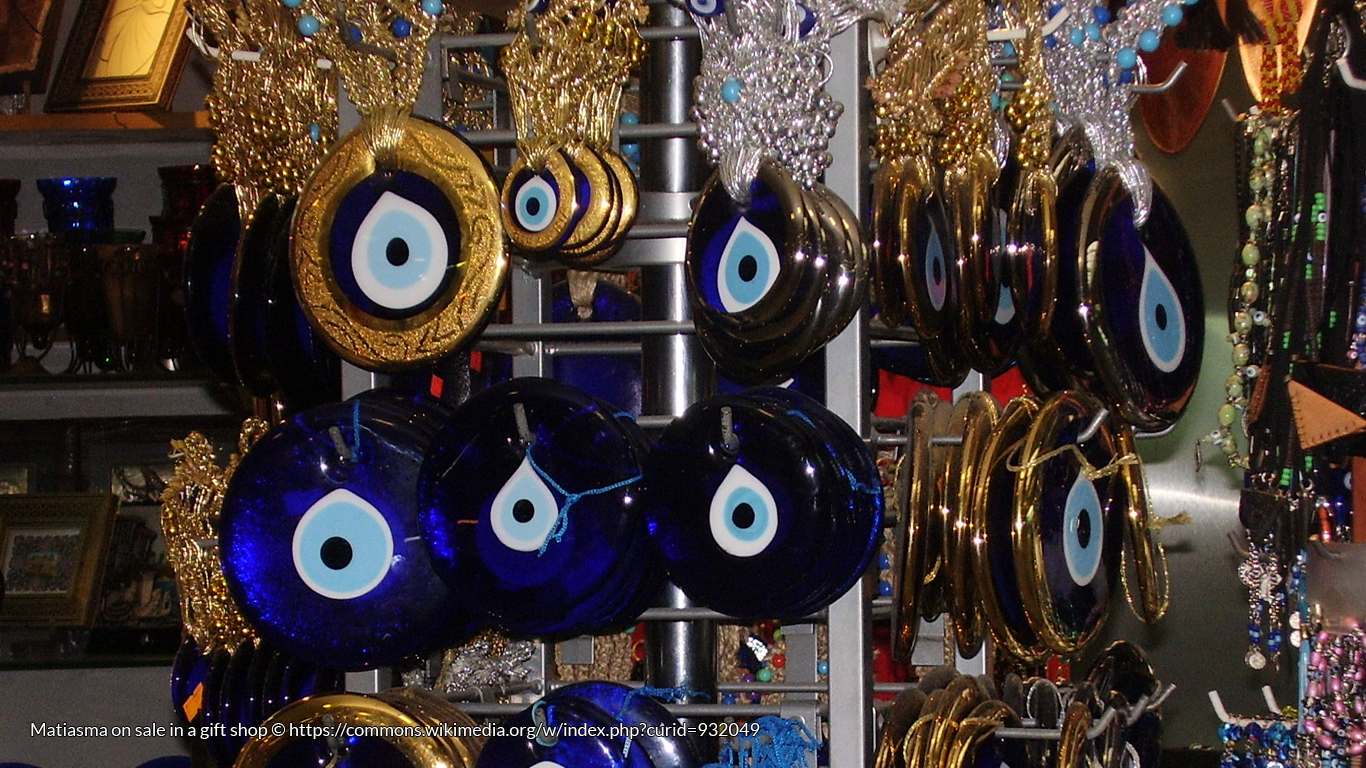The motif of the labyrinth has a long history. Depictions in rock art may date back as far as 10,500-4800 BCE, and can be found from Nevada to Cornwall, from Lancashire to Spain. The purpose of the image is unclear, but they all share the same form – a unicursal, meandering symbol, turning and changing directions from outside to the centre but never crossing itself. But by far the most famous labyrinth of all is that of ancient Crete (image 1, above).
Mythology tells us that this labyrinth was built by the famed craftsman Daedalus on the orders of King Minos, to be the dwelling place of the monstrous Minotaur. This half-bull and half-man fed upon seven youths and seven maidens sent annually from Athens. That is, until the Athenian prince Theseus arrived and slew him, with a little help from Minos’s daughter Ariadne.
The first ancient author to use the term “labyrinth” was the Greek historian Herodotus, writing in the 5th century BC. However, he was referring to an Egyptian, not Cretan labyrinth, built as a memorial to themselves by the nomes (kings) of each of the 12 regions of Egypt:
“It has twelve covered courts, with opposite doors, six courts on the North side and six on the South, all communicating with one another and with one wall surrounding them all. There are two sorts of rooms, one sort above, the other sort below ground, fifteen hundred of each sort, or three thousand in all.” (Herodotus The Histories II, 148)
Later writers explicitly linked this Egyptian labyrinth with that of Crete. Apollodorus, writing in the 1st or 2nd century AD, tells us that the Cretan labyrinth was built by Daedalus, and describes it as a chamber “that with its tangled windings perplexed the outward way” (Apollodorus Bibliotheca 3.1.4). Pliny, writing at the start of the 2nd century AD, brings Daedalus and both the Egyptian and Cretan labyrinths together: “That Daedalus took this for the model of the labyrinth which he constructed in Crete, there can be no doubt; though he only reproduced the hundredth part of it, that portion, namely, which encloses circuitous passages, windings and inextricable galleries which lead to and fro… we must picture to ourselves a building filled with numerous doors, and galleries which continually mislead the visitor, bringing him back, after all his wanderings, to the spot from which he first set out” (Pliny, Natural History, 36.13.19).
The relationship between Crete, the Minotaur, and the Labyrinth was well-known in art, particularly after the 5th century BC when Athens “adopted” Theseus as their historical founder. In Archaic vase decoration, we see him slaying bull-headed men, framed by meander patterns, with, by the later 5th century, the addition of a building. Around this same time, the classical city of Knossos on Crete began to mint coins, the earliest of which shows the Minotaur on the obverse and a labyrinthine swastika with a star or sun motif in the centre on the reverse (image2).
The myth of the labyrinth and the Minotaur persisted well beyond antiquity, with many later traditions based on Ovid’s account of the myth, written c.8 AD. This mentioned the half-man half-bull aspect of the Minotaur, but neglected to mention which half was which – hence the depiction of a more centaur-like Minotaur in many early manuscripts (image 3).
It was also a popular theme in Renaissance art, in which the form of the labyrinth took on the unicursal motif (image 4). Around this time, explorers began to travel to Crete in search of the mythical labyrinth, often searching for a building similar to that described by Herodotus. Although Knossos was its mythical location, the lack of anything resembling a labyrinth at this site led these early travellers to look for it elsewhere.
It was often believed that this famous structure was in a cave site near Gortyn in south central Crete, which was well-illustrated in numerous maps from the 15th to 18th centuries (image 5). This identification was favoured because the ‘Gortyn Labyrinth’ appeared to be manmade, with numerous dead ends creating a honeycomb network which extended for miles underground. Mythology also helped support the identification – Europa was said to have consummated her marriage with Zeus in the form of a bull nearby.

The first foreign traveller to visit the Labyrinth in Gortyn was Cristophoro Buondelmonti in 1415. In his work, Description of the Island of Crete, he identifies the caves at Gortyn as the site of the labyrinth. Other visitors to Gortyn include William Lithgow in 1610, and in 1680 the English traveller Bernard Randolph, who remained in the Labyrinth for one hour. He advanced less than 100 meters, which was the length of the yarn he used to keep from getting lost – no doubt inspired by his mythical predecessor Theseus. His description of the cave is rather vague, but he does mention encountering a large number of bats.
The belief that Gortyn was the mythical labyrinth of Minos was particularly promoted by the Venetian governors of the island, who sought to have the “real” labyrinth in their territory, and they regularly organised journeys to the “Gortyn Labyrinth” for important visitors from Venice. But the idea of the Gortyn Labyrinth didn’t last – by the 18th century, most travellers agreed that it was in fact a Roman quarry. However, even prior to the 18th century, there had been dissenting voices regarding the location of the labyrinth at Gortyn. In 1435 a Spanish traveller called Pero Tafur produced a short description in which he put the Labyrinth at Knossos, “wuth many other antiquities.” Other travellers agreed. In 1745, Richard Pococke favoured “an eminence to the south” of the Roman ruins at Knossos – the Kefala Hill, the location of the Bronze Age palace.
The first excavation at the site of Knossos took place in 1878, under the directorship of the appropriately named Minos Kalokairinos, a local Cretan merchant. He dug 12 trial trenches into the hill, and was constantly coming upon the massive walls of an extensive building, as well as excavating gigantic storage jars known as “pithoi.” However, local authorities prevented any further digging, fearing the Ottoman rulers of Crete (who had taken over the island from the Venetians in 1669) would move any artefacts found to Istanbul.
It was the American journalist W. J. Stillman, a former American consul in Crete, who in the 19th century re-introduced the notion that Knossos might be the Labyrinth of Greek mythology. His articles – in which he referred to the “Daedalian labyrinth”– were widely read and even inspired Heinrich Schliemann (the excavator of Troy and Mycenae) to venture to Crete and dig at Knossos. However, his attempts were denied, which is why it was in 1900 that Arthur Evans, with a new political regime in place, was able to start excavations.
Evans’s work at Knossos aroused widespread public interest, kindled in April 1900 by his cable to the London Times and detailed in a series of succeeding articles. In a Times article of August 10th 1990, Evans took for granted the historicity of Minos, “the great law-giver” who “promulgated his famous institutions and . . . established a maritime empire. . . . Here Daedalus constructed the Labyrinth, the den of the Minotaur, and fashioned the wings—perhaps the sails—with which he and Icarus took flight over the Aegean.” The level of media coverage achieved by Evans in his own time can be gauged even as early as the 4th July 1901, when Sigmund Freud wrote in one of his letters: “Have you read that the English excavated an old palace in Crete (Knossos), which they declare to be the real labyrinth of Minos? … This is the cause for all sorts of thoughts too premature to write down.”
When Evans began at Knossos, he took upon himself the job not just of excavating a building but also of uncovering the sources of the most enduring myths in European history. As he excavated, Evans found images of bulls all over the Palace, some with graceful youths jumping over their backs. But how to explain the origin of the labyrinth? Evans accepted the etymology of the term “labyrinth” proposed by P. Krestchmer and A. Fick, who identified the word as pre-Greek and argued that it derived from the Carian word “labrys,” meaning “axe.” The Carians were ancient inhabitants of southwest Anatolia, and their deity, Carian Zeus Labruandos, was depicted holding a double axe. This etymology continues to be debated, but for Evans it opened a series of explanations, including the significance of the Double Axe signs carved on the pillars and walls of the palace: the Labyrinth was literally the “House of the Double Axe.” Evans’s interpretation even went so far as to suggest that the Labyrinth where Minos kept the Minotaur was the palace itself, with its complex “labyrinthine” structure. Evans associated the unearthed ruins with the mythical Labyrinth, and hence in the early 20th century the mythical Cretan labyrinth became physical fact.

Labyrinth or Maze?
The complex structure of the palace of Minos does not adhere to the design of a proper labyrinth, which is that of a unicursal path leading towards the centre of – usually – concentric circles. The palace of Minos is anything but; indeed Evans pushed the identification through the notion that the extraordinary amount of chambers and corridors that made up the palace made it a labyrinthine structure. The palace was a complicated, branching, multicursal design that included choices of paths and direction. Therefore, technically the palace was not a labyrinth – it was a maze.
However, we still might find the mythical labyrinth at Knossos if we change our perception of what a labyrinth means, and think not what it represents to us but what it might have represented to the ancient Minoans themselves.
Evidence from the palace excavations and elsewhere in the contemporary Aegean world suggest the Minoans were already aware of the motif of the labyrinth. Evans himself excavated fresco fragments in the palace which he named the “Labyrinth Fresco,” discovered in a corridor a short distance to the east of the “Hall of the Double Axes.” Though Evans perhaps imagined a corridor with the labyrinth design painted on the walls, it was more likely to be a painted plaster floor.

A clue to the function and meaning of this may be found if we turn again to literature. Although the first mention of the labyrinth – as far as we know – comes from Herodotus, the earliest literary mention of Daedalus is much earlier, in the writings of Homer in the 8th century BCE. In the Iliad (18, 590-4), the poet describes the finely crafted shield which Hephaestus made for Achilles:
“In which the famed lame-one wrought a chorus like the one that Daedalus fashioned for Ariadne of the beautiful tresses in broad Knossos. There were youths dancing and maidens of the price of many cattle, holding their hands upon the wrists one of the other…. Now would they run round with cunning feet exceeding lightly…and now again would they run in rows toward each other. And a great company stood around the lovely dance, taking joy therein; and two tumblers whirled up and down through the midst of them as leaders of the dance”
The word “chorus” has several meanings. It can refer to the chorus of a Greek play, and it can also mean a winding dance or dancing place. Could it be that the meandering pattern on the floor of the palace represents the pathway of a labyrinthine dance? Was the labyrinth that Daedalus built not a maze-like prison, but instead a dancing floor?
In 1909, Evans found a gold signet ring engraved with a ritual scene that he believed represented an element of the labyrinthine dance. The scene shows four women in Minoan dress in a field of lilies, which Evans interpreted as a dance of ecstatic possession to invoke the goddess.

In an address later that year to the Royal Institute of British architects, he showed the ring and reconstructed for the audience the “orgiastic dance” – whirling and labyrinthine – that he believed was held in honour of the Mother Goddess in the “Dancing Place of Ariadne.”

Linear B texts from Knossos also add to the picture. A tablet from Knossos (KN Fp 1) lists various offerings of olive oil being sent to sanctuaries, deities, and religious personnel, including an entry which may be interpreted as “to the shrine of Daedalus.” Two other tablets (KN Gg 702 and Oa 745) list a recipient of offerings which, when translated, has been interpreted as “Lady of the Labyrinth.” All of which suggest a ritual meaning to both Daedalus and the Labyrinth.
More images of dance would appear throughout Evans’s excavations of the palace. Evans also asserted that an impression of the original “maze-like” dance could be gained by viewing the dances which were still performed in the neighbourhood of Knossos by the Cretan peasants. Evans employed local Cretan workmen, both Muslim and Christian, to work on the excavations and he often had them celebrate joint holidays together with games and dances: “the sinuous, meandering course of the dancers, as they were led hand in hand by the chief performers in each set, was curiously appropriate to the ancient traditions of the spot.” Here, Evans was hinting that the Minoan labyrinth dance had survived the centuries, and, only through his excavation and rediscovery of the palace of Knossos, could its real significance finally be seen.
The idea of the Cretan labyrinth may well be a later confusion between the sprawling, multilevel building at Knossos – a maze – and the configuration known as the labyrinth, a marked area for sacred dances. Whichever is true, the Cretan labyrinth provides a complex case study on the intersection of myth and history. While we may debate the archaeological and historical veracity of myth, and of Evans’s interpretation of that myth, we can be sure that, just like the ancients, the Labyrinth of Crete will always occupy a powerful place in our collective imaginations.
Recommended Books from #FolkloreThursday
References and Further Reading
Castleden, Rodney. 1990. The Knossos Labyrinth: A New View of the ‘Palace of Minos’ at Knossos. London: Routledge
Evans, Arthur. 1903. ‘The Palace of Minos. Provisional Report for the Year 1903,” Annual of the British School at Athens 9, 130-153
Gere, Cathy. 2009. Knossos and the Prophets of Modernism. Chicago: The University of Chicago Press
Masson. J.M. (ed.) 1985. The Complete Letters of Sigmund Freud to Wilhelm Fliess, 1887-1904. Cambridge, MA: Harvard University Press







